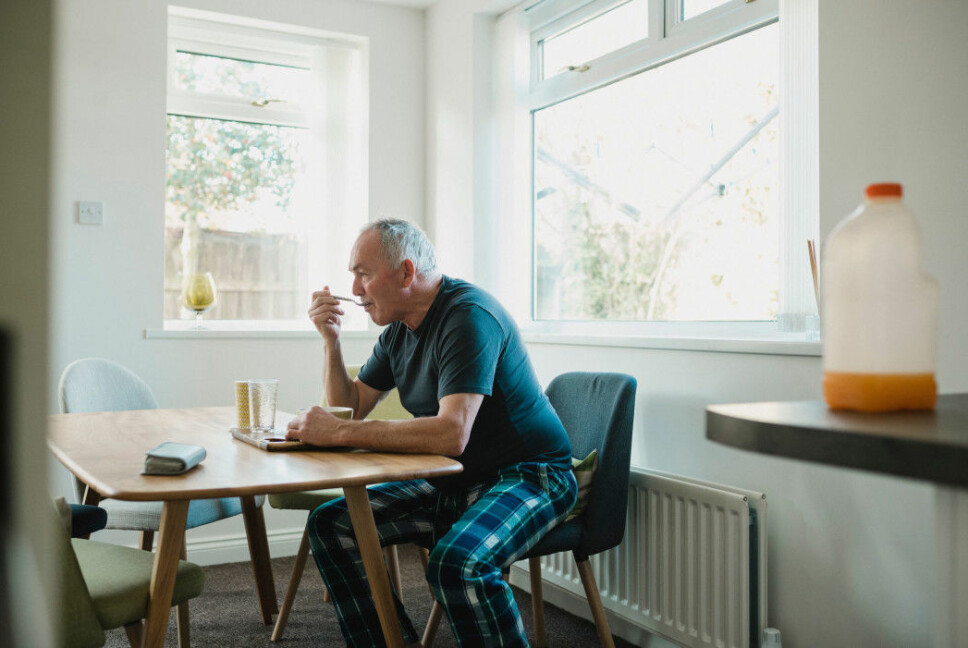
Dramatic increase in mortality among the unmarried
Unmarried people die far earlier than those who are married. The disparity has widened significantly in the last 40 years.
Mortality – or the frequency of deaths – has been steadily declining in Norway over the last hundred years in comparison to people of the same age.
Our health has been improving and our life expectancy is increasing.
But for many decades, a large segment of society has not taken part in this positive development in health.
Those who are not married.
Dramatic increase
Øystein Kravdal is a demographic researcher and an expert on changes in our population.
He has become aware of a startling fact: The difference in mortality between unmarried people and married people in Norway has increased sharply over the last 40 years.
Unmarried adult men now have almost twice the mortality rate of married men of the same age. Unmarried adult women also have much higher mortality rates than married women.
“In 1975, the mortality rate of nonmarried men and women was about 20 per cent higher than among married couples,” says Kravdal.
“Now the unmarried mortality rate is more than 80 percent higher!”
Over the past 40 years, the proportion of unmarried people over age 50 in society has decreased. But the proportion of unmarried people in the younger age groups is growing.
What exactly does mortality mean?
As we all know, the probability of dying at some point in our life is 100 per cent.
The probability that you will die within the next year is clearly much lower but increases with age.
It is when Kravdal compares people of the same age that he finds the probability of dying – the mortality rate – is 80 per cent higher for unmarried than for married individuals.
Mortality for unmarried men over 50 today is almost twice as high – every year – as it is for married men of exactly the same age.
Unmarried women have at least 1.7 times the mortality rate of married women of the same age.

Kravdal was taken aback by these figures.
And this data is not just about unmarried people being sicker than married people.
“For example,” he says, “if we compare people who have exactly the same cancer, in the exact same organ, discovered at the same time, then we see that individuals who are not married are doing worse.”
Kravdal points out that this may be because unmarried people often have other illnesses concurrently. Unmarried people may also benefit less from the treatment they receive.
Unmarried health improvement lagging
Year by year, the Norwegian population is experiencing better health and living longer.
But compared to married couples, nonmarried people are probably about 30 years behind in their health improvement.
The mortality figures Kravdal found are based on the Norwegian Population Register, which includes the country’s entire population.
Interested colleagues abroad have told Kravdal that a similar trend is likely occurring in other countries as well. French researchers are investigating whether they see the same mortality pattern as in Norway.
Fewer people marrying
It has been known for many years that people with higher education on average have a much higher life expectancy than people with less education.
Health researchers have also known that married people generally enjoy better health and live longer than nonmarried people.
The findings from the Norwegian Institute of Public Health show that this last difference has increased sharply.
Researchers may also find in the coming years that a growing percentage of the population is unmarried, eventually extending to older age groups.
Men and women who are divorced or widowed also have higher mortality rates than married people of the same age.
But neither of these two groups show as negative a trend as do unmarried men and women.
Has the social glue become weaker?
What can explain these disparities?
Kravdal and his research colleagues have no clear answers.
But they’re speculating.
One possible explanation may be that the social glue in our culture has become weaker, making it more difficult to manage life alone.
Maybe people don’t take care of each other as well anymore, and perhaps this is especially true of those who don’t have a spouse?
“We can certainly ask the question. But there are no clear signs that the glue between people in Norwegian society has become weaker,” says Kravdal.
Difference due to cardiovascular disease?
Another possible explanation may be that the health care system has become more complicated. Maybe you need a supportive spouse to help you navigate your way to good health services in Norway.
The hypothesis is that unmarried, divorced and widowed people underuse health care services compared to married people. The difference may have widened as Norway’s health services have steadily improved.
“It’s possible that this can explain part of the difference,” says Kravdal.
“Another study indicates that unmarried people probably use too little medication for cardiovascular disease. We’ve seen big advances in treatment that have strongly contributed to the rapid drop in cardiovascular mortality in society,” he says.
Cardiovascular mortality is twice as high for nonmarried people as for married people, Kravdal notes. This statistic is true for both men and women
How important are economics and lifestyle?
Could money play a role, too?
After all, a relationship has financial benefits. Just being two people together creates economies of scale. You have two incomes, but you only need one house and one car.
Perhaps the economic benefit of being married has increased in line with rising home prices. Or there could be other financial explanations. This we do not know.
Might single people end up with poorer health because they have a different diet?
Preparing healthy foods often takes a little longer. Cooking can be boring if you live alone.
Or how about smoking – possibly the worst way to endanger your health?
Maybe having a spouse has increasingly kept people from smoking as its dangers have become more known. More people now smoke among unmarried than among married people.
Quality of relationship important
Frode Thuen is a professor of psychology and a cohabitation expert. He has read the Kravdal study and is not surprised that couples are healthier than people living alone.
“We know from experiments that the brains of people who hold their loved one’s hand when they’re exposed to pain react less than people who don’t have a hand to hold. But we also know that the quality of the relationship is as important as having a partner,” says Thuen.
He points to a study from the University of Bergen that showed that pregnant women who are dissatisfied with their relationship have an increased risk of several infectious diseases.
We also place greater demands on relationships today than a few decades ago, Thuen says.

“Back then fewer people divorced, and partners didn’t always provide that much support. There were also less demands on a partner. Today, we have more freedom to move out of a non-functioning relationship, so we can expect the quality of the relationship to be better than before,” he says.
He believes this may also partly explain why a lot of people don’t enter into a relationship.
Today, a relationship is supposed to meet all our needs. That can make it difficult to find the right person.
“People would like to have a lifelong relationship with a partner. And that person should be your closest confidant, soulmate and preferably your therapist, too,” Thuen says.
Children can improve health
In a recent study, Kravdal also considered the connection between having children and parent mortality.
He found that both men and women without children have decidedly higher mortality rates than people with children. On average, a woman without children has 70 per cent higher mortality than a woman with two children. For men, the difference is slightly less.
“We’ve known for quite some time that children, in general, protect the health of parents. Health researchers have become more interested in this phenomenon lately. In addition to children affecting their parents' lifestyle and eventually being able to provide help, women experience certain biological effects from pregnancy. These can cut both ways: The risk for some diseases increases, while for other diseases the opposite is true.
Maybe selection is a factor?
Women and men choose each other. Could it be that we are becoming increasingly critical and demanding when choosing a spouse?
Kravdal poses questions along the same line.
“Are good health and healthy behaviour increasingly becoming prerequisites for men and women to be considered attractive enough to be chosen as spouses?
“Are people with certain personality traits and poorer health prospects being deselected from marriage?”
These questions are currently only hypotheses, Kravdal says. There is no concrete evidence for them in research. But it may be that the topic has not been investigated well enough.
Education and income have traditionally increased a man’s chances for marriage. For women, however, the connection between education and marriage has traditionally been a negative one.
“Now we’re seeing that this link is about to become more equal for the sexes,” says Kravdal.
“Men also want a wife who can contribute to the bank account, not just one who is good at managing the home. ”
Some of the disparity in mortality between nonmarried and married individuals may be that people with poorer health are less likely to marry. And some of the difference between couples with and without children may be due to some childless couples having health problems to begin with.
In addition, certain social conditions and people's perceptions of what a good life is may affect both the number of children and parents’ later health and mortality.
Political measures
The development of greater and, in some cases, increasing differences in mortality between people who are married and those who are not married is becoming increasingly alarming, given that more and more people in our society are likely to remain unmarried in the future.
Kravdal urges the government to put this issue on Norway’s health policy agenda.
And he has some suggestions for what can be done.
“First, we need to have research that tells us with greater certainty whether unmarried people underuse the health care system. If this is confirmed, we could introduce a scheme where GPs invite anyone who lives alone to come in for a free health check once a year, for example,” Kravdal says.
“If research confirms that a supportive spouse is important for dealing with a complicated health care system or following up on a treatment plan, we can encourage health professionals to keep an eye on unmarried people and follow up with them extra well,” he says.
“Especially unmarried people with chronic illnesses may need more help than others.”
Psychologist Frode Thuen doubts whether this topic should be included on the health policy agenda.
“The figures are clear and serious. But we don’t yet know exactly what it’s all about, which makes it difficult to know how the government should handle it,” says Thuen.
Besides, this is a difficult message to communicate, he says.
“It’s one thing when you can't find a partner you want to live with. If on top of that you’re then seen as belonging to a risk group, the stigma of living alone can easily be an additional burden."
Translated by: Ingrid P. Nuse
References:
Ø. Kravdal (2017): Large and Growing Social Inequality in Mortality in Norway: The Combined Importance of Marital Status and Own and Spouse’s Education, Population and Development Review.
Ø. Kravdal, E. Grundy og K. Keenan (2018): The Increasing Mortality Advantage of the Married: The Role Played by Education, Demographic Research.
Ø. Kravdal og E. Grundy (2014): Underuse of Medication for Circulatory Disorders Among Unmarried Women and Men in Norway, BMC Pharmacology and Toxicology.
Ø. Kravdal (2013). The poorer cancer survival among the unmarried in Norway: Is much explained by comorbidities?, Social Science & Medicine, 81, 42-52.
Ø. Kravdal, A. Tverdal og E. Grundy (2020). The association between parity, CVD mortality and CVD risk factors among Norwegian women and men», European Journal of Public Health. In press.
Ø. Kravdal, P. Magnus, B. Moum og M. L. Høivik (2020). Childbearing is Associated with a Short-term Reduced Risk of Crohn’s Disease in Mothers, American Journal of Epidemiology. In press.
———
































